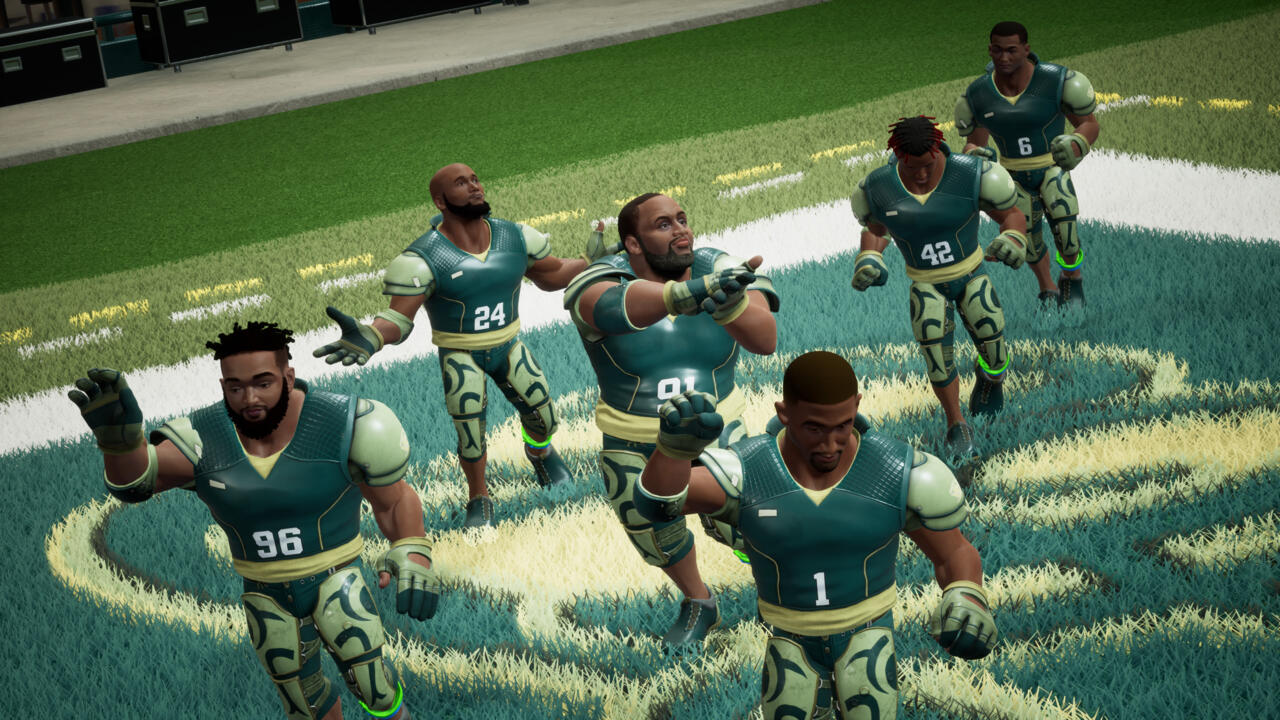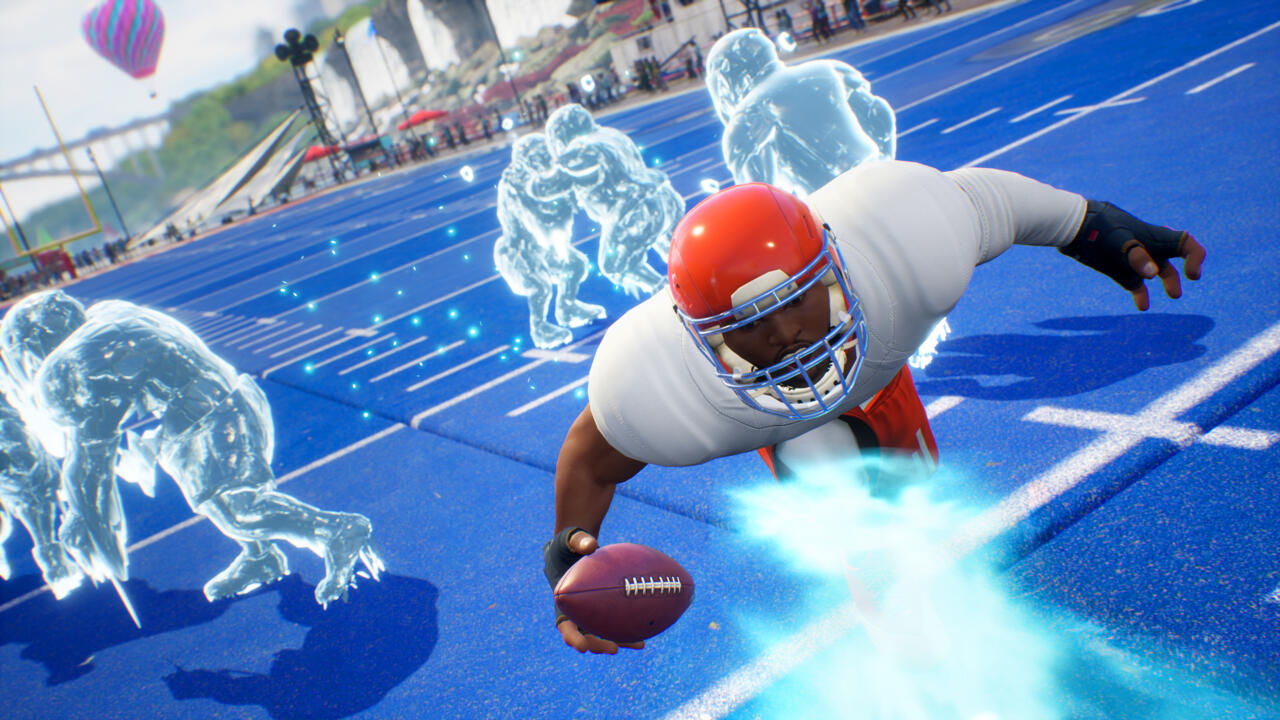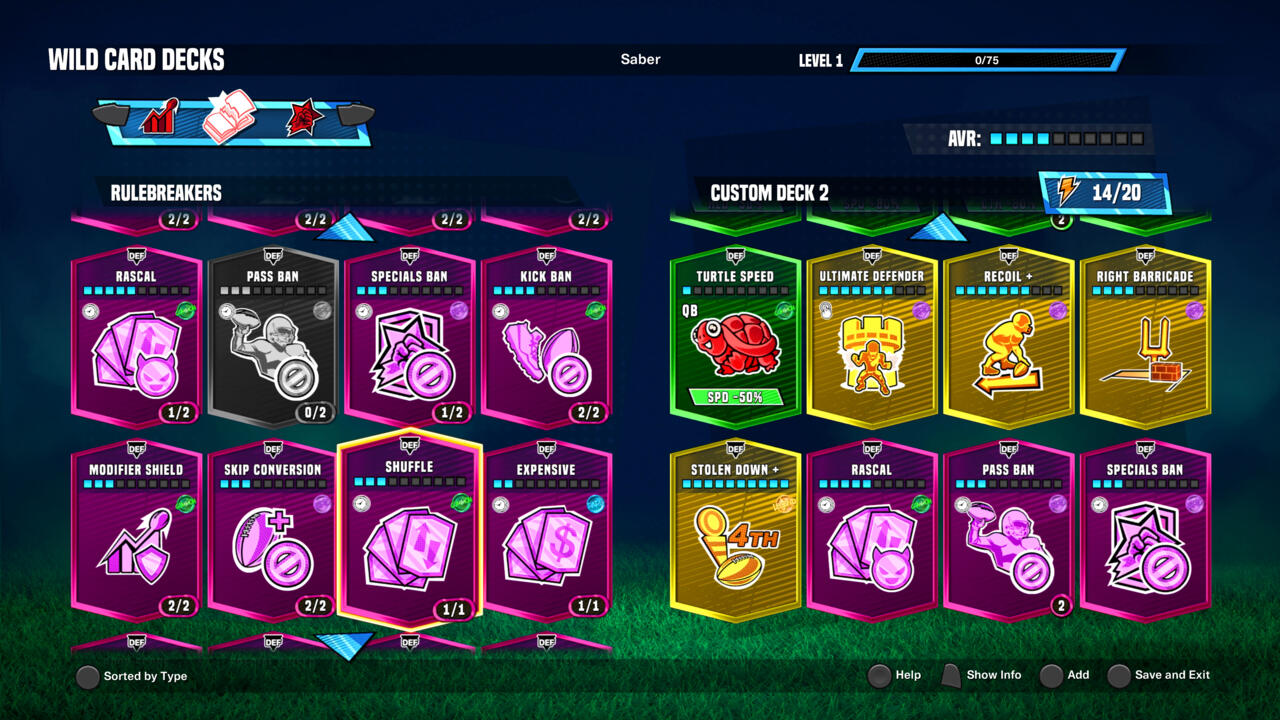In the US, autumn belongs to football. The sport takes over pop culture in a way no other can match, and after decades of growth, it seems to still be getting more popular. So surely there's room for a second licensed football game on the market, especially when the industry leader is itself so polarizing. That's where Wild Card Football hopes to exist: in the abundant space devoted to football fandom that could host either a Madden alternative, or more likely, a side attraction. Unfortunately, this much more cartoonish take on the sport doesn't quite make the roster, though it's not without a few highlights.
Wild Card Football is an arcade-style football game in the vein of NBA Playgrounds and WWE 2K Battlegrounds. In fact, it comes from the same studio, Saber Interactive, and is billed as part of the broader Playground Sports brand. Somewhere between the enjoyable basketball game and the severely lacking pro wrestling game sits this third take on the format.
Wild Card Football is played in teams of seven, and though it doesn't have a licensing deal with the NFL, it does have one with the NFLPA, meaning current players from every team make up the game's complete roster. Jerseys and team names are legally distinct, but a football fan can easily deduce that Team Mahomes is the Chiefs, Team Hurts is the Eagles, and so on.

This is an important detail, as it immediately adds some excitement to see familiar stars on the field. However, it was difficult throughout my time with the game to feel like those stars. The arcade-like gameplay has a way of generalizing the players, leaving the best of the best like Tyreek Hill or Travis Kelce, and the more middling guys like Nick Westbrook-Ikhine and Tyler Algier, feeling too athletically similar. This makes those famous names and faces feel like only that.
The titular "wild cards" are aptly named. Before each down, you can play power-ups and modifiers that will either buff your players or nerf your rival's. But like the players, the benefits of these aren't always as obvious as they're clearly meant to be, and sometimes they're awkward to activate. A card that reduces the speed of my opponent by 50% for one play sounds devastating, but I found no rhyme or reason in how I'd fare on such plays, even when running things like wide receiver streaks or running back sweeps that should display the speed disparity quite clearly. Other major modifiers, like creating an alien invasion on the field or giving a ball carrier invisibility, are the sort of over-the-top imagery the game is sold on, but I enjoyed my time with the game most of all when wild cards weren't in play, because they're so common and can sometimes feel so pointless anyway.
All they do consistently is slow a game down as teams select their cards before virtually every down. Because you can see your opponent's cards, oftentimes teams would just offset each other, like when I'd play a card that gives my team a 50% speed boost, but my rival would play a card that reduces my team speed by 50%. This happened often. I disliked this process so much that I actually stopped using them much of the time, especially against the CPU, and my play on the field didn't suffer, which indicated to me that they really aren't adding much to the game.
Even in games where wild cards aren't allowed, an initial quicktime event (QTE) at the snap of the ball features a timing window that is too short for the average player. And when that QTE fails on offense, you're liable to run for a loss or no gain at best. These issues combined to create a game-long cadence where my allegedly standout players would routinely be hamstrung by too-common power-ups or punishing QTEs. Instead of over-the-top tackle animations and cartoonish touchdowns deserving of a highlight reel, many plays would lead to vanilla incompletions or short runs the likes of which don't make memories. When I would break a big play or hit the timing window just right to make a big third down stop, I saw glimpses of the game's best bits--but these only happened about half the time in any given game. The other half unfolded as broken plays.

Animations are fun, anyway, including some comical gang tackles, stiff-arms that lead to backflips, and some sacks that make the QB look like a Looney Tunes villain getting their comeuppance. But even then, post-play flourishes like emoting players seem to occur after nearly every play. Even in a lighthearted setting such as this, I don't want most plays to go on twice as long because a player has to first finish their dance moves. But the worst presentation feature is surely Chris Berman's involvement. The longtime ESPN personality lent his voice to the game, but it's used so sparingly and he sounds so phoned in that it would definitely be an addition by subtraction to have produced the game without his efforts. He says something at the start and end of the game, and then never again except for, oddly enough, timeouts. Ends of quarters and all plays in between come and go without his involvement.
Games are short--meant to be finished in about 15 minutes or so--across modes that include online and local PvP, a solo Tour mode, which throws seemingly randomized challenges at you as you scale a rewards tree, and the game's central attraction, Dream Squad. In Dream Squad, the legally distinct rosters are thrown out in favor of a fantasy-football-style mode that shuffles players around and hits them with massive ratings nerfs to give you upgrades to chase. This is, essentially, the game's Ultimate Team mode, and both the aforementioned Tour and the online League play reward loot boxes that cannot be purchased otherwise, which grant you new cosmetics, emotes, and, most importantly, these player cards. Divided into color-coded loot tiers, each player starts bad, with overalls somewhere in the 40s-60s, but has a skill ceiling determined by their rarity, meaning a legend (gold) card can become better with playing time than a (common) green player card.
The process of improving players is rather slow and seems overly optimistic about the likelihood of players devoting a lot of time to this game. It even has daily challenges, but doesn't really justify that sort of playing schedule given the middling on-field experience. The inclusion of loot boxes, even as they are not available for purchase, feels odd in a 2023 console game. I'd much rather climb for specific rewards, which is something similar modes have been adopting for a few years now.
Despite that, I would say Dream Squad is my preferred mode, but that's only relative to the others which I found forgettable. It's nice to have PvP options for both local and online play, but the team-building process of Dream Squad is a more involved longform task than running around with squishy versions of NFL stars through a season. And even though microtransactions are nearly absent in this mode, the ability to get a head-start on the competition by buying one of the game's two more expensive versions does feel like an unforced error. We're years into sports games getting away with lousy pay-to-win tactics, and Wild Card Football could've been a welcome respite from that world. While it shows much more restraint than Madden or NBA 2K, Dream Squad can still become a matchup of haves versus have-nots.

The game's absolute best parts all revolve around customization. In Dream Squad, you create your own team logo and team name, create a color scheme, choose a stadium, and make custom uniforms, either piece by piece with a wide range of options like Darth Vader-style helmets and off-brand Chuck Taylors for cleats, or with full sets of outlandish outfits like pirates or teddy bears. Each player on your team can be assigned their own emotes, and you can allow individual players' customized kits to supersede the team uniform, giving you an army of colorful misfits. There's a ton there right away and you'll keep earning more as you play Dream Squad and earn more loot boxes. You can also create your own wild card decks and playbooks, the latter of which I really love doing.
The intent of Wild Card Football is evident, but too often its good parts are buried beneath its worst aspects. Customization is fun, animations are absurd, and when a game is clicking, it can feel like a decent romp in between--or as salvation from--Madden games. But it doesn't click often enough, making each game feel sluggishly paced despite the short quarters. Finding the fun in something that visually looks so fun is trickier here than it should be, but the unintended parity among players plus the overuse of the game's faulty namesake feature makes Wild Card Football play like the expansion franchise it is.